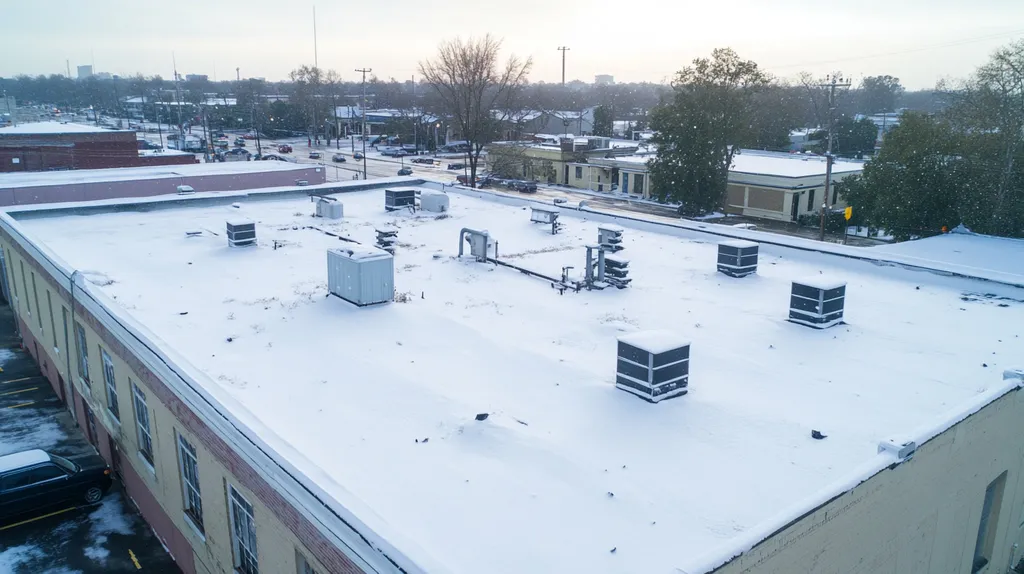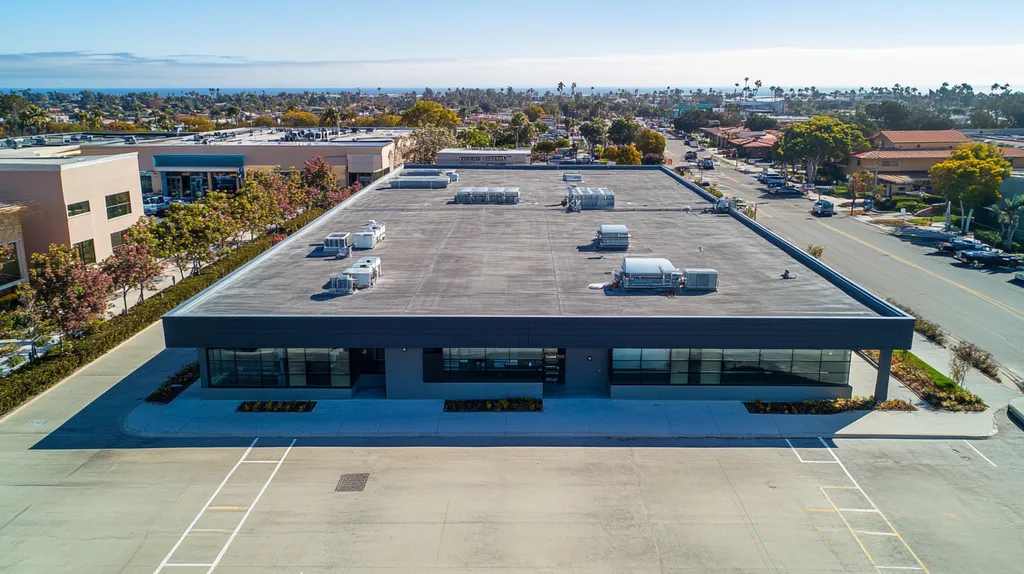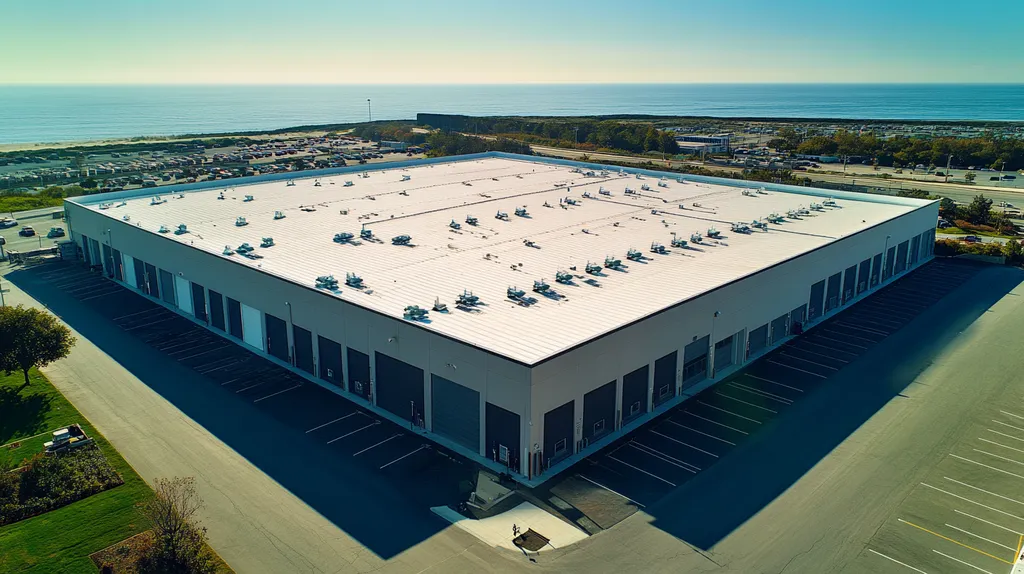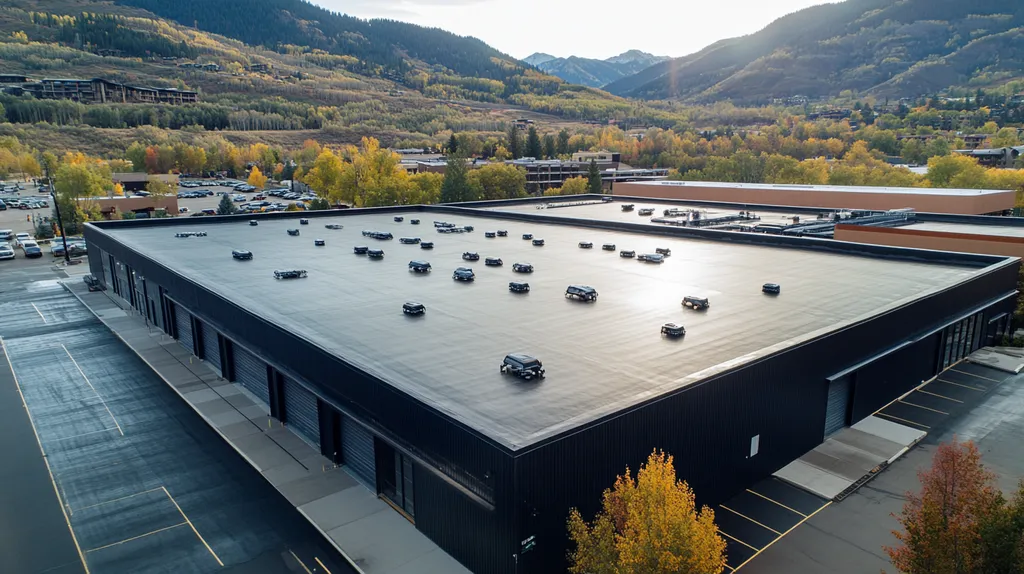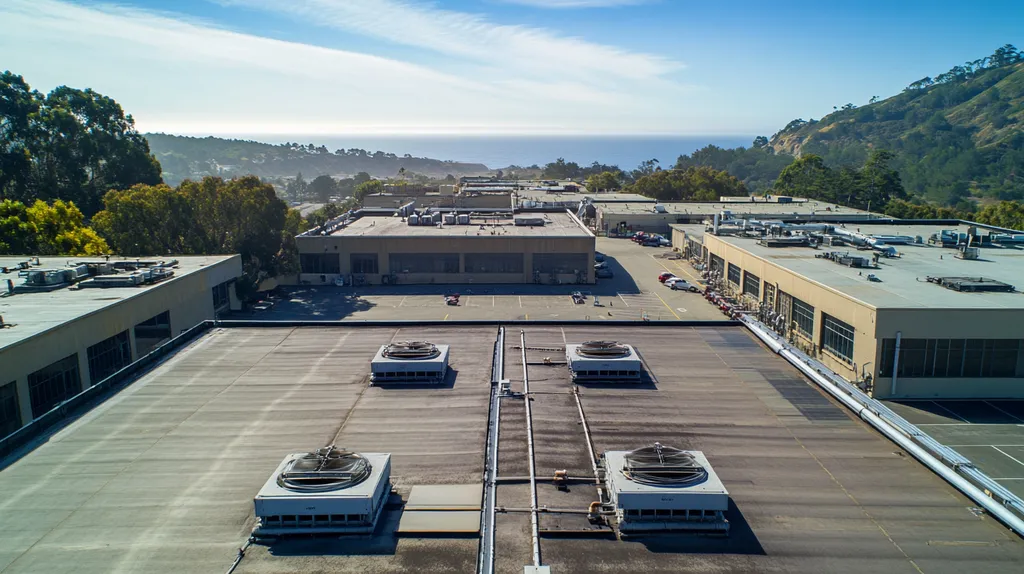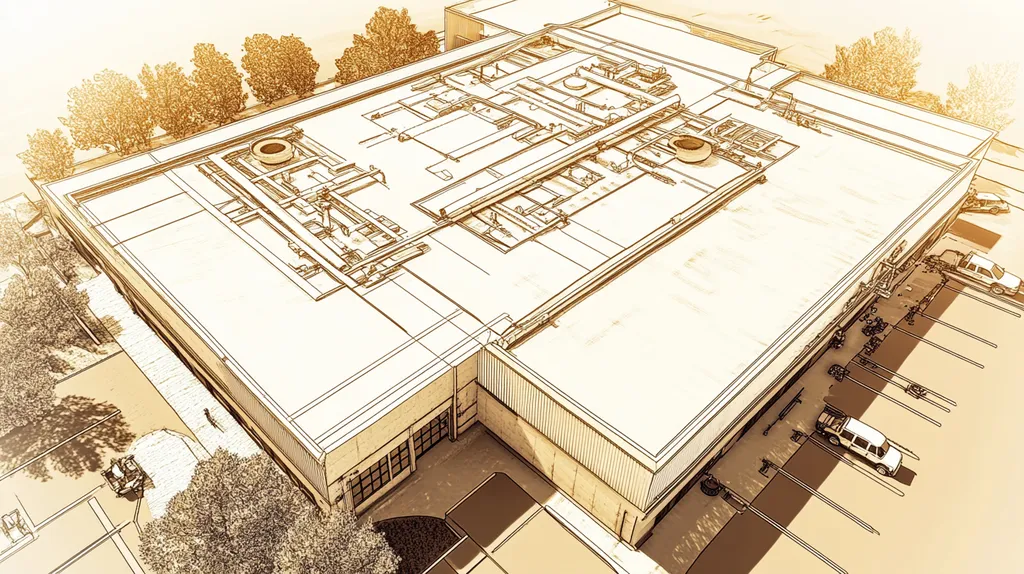When it comes to lighting on sloped industrial roofs, the industry has been getting it wrong for decades. Studies show that up to 40% of workplace accidents in industrial settings can be traced back to inadequate lighting on angled surfaces.
From uneven illumination that creates dangerous shadows to energy-wasting fixtures that hemorrhage operating costs, traditional approaches are failing both safety standards and bottom lines.
This analysis challenges conventional wisdom about sloped roof lighting, examining why current practices fall short and exploring innovative solutions that are transforming industrial illumination.
SECTION 1: CURRENT PRACTICES
Proper lighting on sloped industrial roofs is not just a matter of aesthetics—it’s a crucial aspect of maintaining safety and productivity. Inadequate lighting can create hazardous environments, eroding worker confidence and leading to costly operational setbacks. Studies reveal that insufficient lighting is a factor in nearly 30% of workplace accidents, underscoring the critical need for effective lighting strategies specific to sloped roofs.
Standard Lighting Fixtures for Sloped Ceilings
Standard lighting fixtures frequently miss the mark when addressing the distinctive challenges of sloped roofs. Most designs cater to flat surfaces, resulting in uneven light distribution and creating dark corners that hinder visibility where it’s most needed.
The industry often leans towards high-bay LEDs, but these lights may struggle to provide the necessary brightness across various slopes. Glare becomes another issue, making work conditions uncomfortable and distracting. Thus, choosing the right fixture is paramount for optimizing lighting on sloped roofs.
Moreover, existing guidelines often ignore critical installation details required for sloped applications. For example, fixtures need to be adjusted to align with the roof’s angle to ensure consistent light output. Failing to make these adjustments can lead to a significant drop in lighting effectiveness.
Consequently, relying on standard fixtures risks compromising safety and undermines productivity across industrial facilities. It’s clear that a more thoughtful approach to lighting design is essential.
Common Installation Mistakes on Sloped Roofs
Installation blunders can severely undermine the performance of lighting systems on sloped roofs. One of the most common pitfalls is misalignment of fixtures. When fixtures aren’t properly aligned, shadows can form and create dark zones, elevating the risk of accidents.
Another frequent misstep is ignoring the roof’s angle during installation. This oversight can lead to fixtures being positioned at inappropriate heights or angles, severely compromising their effectiveness. On sloped roofs, this can dramatically reduce the quality of illumination.
Additionally, using unsuitable mounting equipment compounds the problem. Many installers overlook factors like wind resistance or external forces that impact the stability of fixtures on slopes. This can result in loose fixtures or, worse, complete falls, introducing significant safety hazards.
These common mistakes emphasize the pressing need for specialized expertise in sloped roof lighting installation. Correcting these errors is crucial for enhancing safety and improving operational efficiency.
Industry Norms in Roof Lighting Design
Today’s industry standards often advocate a cookie-cutter approach to roof lighting that overlooks the special requirements of sloped roofs. This oversight can result in poor lighting conditions, adversely affecting safety and productivity. Facilities managers may end up employing lighting designs that simply don’t meet their operational needs.
Furthermore, established practices typically prioritize cost savings over functionality, which leads to subpar lighting solutions. For instance, the tendency to install fewer fixtures on sloped roofs can lead to glaring gaps in light coverage. Such short-sightedness can prove costly in terms of accidents and diminished employee efficiency.
Compounding this issue is the absence of updated guidelines tailored to sloped roof lighting. Many installations still cling to outdated standards, stifling necessary advancements that could lead to improved workplace safety and conditions.
Ultimately, a thorough reexamination and modernization of these industry norms is vital to better align lighting practices with contemporary safety and efficiency needs. A shift towards innovative solutions will better serve users who operate in sloped environments.
SECTION 2: SYSTEMIC ISSUES
The implementation of lighting systems on sloped industrial roofs presents urgent systemic challenges that can dangerously impact both efficiency and safety. Poorly lit work areas significantly contribute to workplace accidents, and statistics from OSHA reveal just how critical this issue is for protecting the workforce—and the bottom line. Addressing these challenges is not simply a box to tick; it’s a necessity for functionality and safety in any industrial setting.
Uneven Illumination and Glare Problems
Traditional lighting designs often miss the mark on sloped roofs, leading to bouts of uneven illumination across workspaces. When fixtures are fixed at a specific angle, the pitch of the roof can create blinding glare rather than the clear, focused light workers need.
This inconsistency not only hampers visibility but can derail productivity, causing costly errors and potential accidents. An environment burdened by harsh glare can detract from workers’ concentration, especially in roles demanding precision, such as assembly lines or quality inspection.
Moreover, the issue of glare isn’t just an annoyance—it can lead to eye strain and fatigue. Addressing these concerns requires intentional selection of light fixtures and strategic placement that complement the slope of the roof. Innovative adaptive lighting solutions can significantly enhance safety and productivity on sloped roofs.
Aesthetic Incompatibilities with Roof Design
Beyond functionality, the aesthetic implications of lighting installations on sloped roofs cannot be ignored. Conventional fixtures often clash with the roof’s design, resulting in an appearance that can be less than flattering. For facilities located in high-visibility areas or subject to zoning regulations, this can be a major concern.
Property owners must understand that effective aesthetics can enhance customer perceptions and bolster a brand’s image. Thoughtfully designed lighting systems that harmonize with the building’s structure not only improve utility but can elevate the property’s marketability.
Furthermore, incompatible lighting can limit design potentials. Facilities aiming for aesthetic cohesion should consider customizable fixtures that blend seamlessly into the overall architecture. Integrating effective lighting while prioritizing visual appeal can substantially increase a property’s value and reputation.
Safety Hazards in Lighting Installation
Installing lighting on sloped roofs inherently raises safety concerns, particularly during the installation phase. Workers are at greater risk of falls or accidents when harnessing elevated fixtures on inclined surfaces. Alarmingly, industry reports indicate that these incidents frequently lead to serious injuries.
To combat these challenges, proper training and robust safety protocols are vital. Equipping workers with appropriate tools and protective gear is essential during installation and maintenance. However, the rush often associated with projects can increase the chance for oversight—often with dire consequences.
In addition to installation hazards, poorly designed lighting systems can create long-term maintenance challenges. Over time, fixtures may need adjustment or replacement, complicating safe access and putting workers at further risk. Prioritizing designs that facilitate easy maintenance without compromising safety is essential for lasting functionality.
Selecting a contractor experienced in the nuances of sloped roof lighting can make all the difference. A knowledgeable partner can ensure installations meet safety standards and provide the necessary illumination effectively.
SECTION 3: MISSED OPPORTUNITIES
The need for effective lighting on sloped industrial roofs is more pressing than ever. As energy expenses continue to climb and sustainability takes center stage, many facilities are overlooking key opportunities for efficiency and innovation. Surprisingly, inadequately utilized lighting can inflate operating costs by up to 30%. Recognizing these gaps enables property owners to make smarter, more impactful decisions regarding their roofing configurations.
Energy Efficiency Gaps in Current Lighting
Current lighting approaches for sloped roofs often neglect the critical aspect of energy efficiency. Standard fixtures, designed for flat surfaces, typically operate below their optimal efficiency levels when placed on a slope. This results in wasted energy and higher bills.
Take outdated fluorescent lights, for instance. They guzzle energy and perform poorly compared to modern alternatives. Switching to LED fixtures can enhance efficiency by up to 75%, while also lasting significantly longer. Yet, many facilities stick with legacy systems, held back by a mix of inertia and ignorance.
Adopting cutting-edge lighting technology can dramatically improve energy consumption. Smart lighting systems that adjust based on natural light or occupancy can yield substantial savings and cut down on environmental impact. These strategic upgrades not only help the bottom line but also showcase a commitment to sustainability.
In short, paying attention to energy efficiency on sloped roofs isn’t just a nice-to-have—it’s a path to financial advantage and responsible resource stewardship.
Neglected Benefits of Adjustable Fixtures
Adjustable fixtures offer a goldmine of optimization opportunities that many property owners overlook. Often, fixed lights are installed without considering the unique needs of sloped roofs. This can lead to frustrating shadowing and reduced effectiveness.
For example, adjustable LED fixtures can be positioned to ensure even light distribution across sloped surfaces. This eliminates dark spots and enhances safety, especially in areas where machinery is operated or workforce movement occurs frequently.
Furthermore, adjustable systems provide the agility needed for evolving requirements. Whether it’s adapting to varying shift schedules or seasonal changes in daylight, these flexible fixtures cater to the dynamic nature of modern industrial operations.
By investing in adjustable lighting, facilities can maximize visibility while minimizing energy waste, effectively balancing operational efficiency with worker safety. In today’s industrial landscape, these are essential elements for success.
Overlooked Aesthetic Enhancements
Lighting on sloped roofs isn’t just about functionality; it’s also a chance to make aesthetic improvements that property owners often neglect. Smart lighting design can elevate industrial spaces from mundane to visually striking. Failing to consider this aspect risks undermining the facility’s overall value and image.
Incorporating sleek, modern lighting designs can improve not only visibility but also the architectural appeal of a building. When clients and stakeholders see a well-lit, contemporary facility, it sends a clear message: this property is state-of-the-art and meticulously maintained.
Moreover, eye-catching lighting can highlight specific architectural features, crafting a more welcoming environment. Enhanced aesthetics can bolster workplace culture and potentially attract top talent, creating a ripple effect of benefits.
Ultimately, prioritizing aesthetic considerations in lighting design amplifies the perception of a facility. This can have lasting impacts on brand reputation and customer loyalty—acknowledging this lost opportunity is crucial for any savvy property owner.
SECTION 4: ROOT CAUSES
When it comes to lighting on sloped industrial roofs, many properties grapple with significant issues that drive up costs and compromise safety. The root of these challenges can often be traced back to three key areas: a glaring lack of customization for varying roof slopes, insufficient attention to local climate, and a troubling shortfall in installer training. Tackling these underlying problems is essential to transform roof lighting from a potential hazard to an asset.
Lack of Customization for Roof Slope
The common approach to lighting sloped roofs is painfully generic, like trying to fit a square peg in a round hole. This cookie-cutter mentality results in setups that do little to address specific slope angles, creating stubborn shadows and uneven illumination. Imagine a light fixture blazing away at the peak of a slope while leaving the lower sections shrouded in darkness—hardly ideal for safety or productivity.
When workers squint to see their tasks or navigate dimly lit areas, mistakes abound, significantly raising the risk of accidents. The cost of these oversights goes beyond minor injuries; it impacts overall workplace safety ratings and can even prompt costly legal battles. It’s high time for customized lighting solutions tailored to the angles and orientation of sloped roofs.
Investing in such personalized setups not only boosts safety but also leads to long-term savings. Highly efficient lighting reduces energy consumption, making more comfortable and productive working conditions a reality that property managers can no longer afford to ignore.
Inadequate Consideration of Local Climate
Local climate shouldn’t be an afterthought in lighting strategies; it’s a fundamental factor that can make or break an installation. Yet, many current setups overlook how weather patterns influence lighting needs and the reliability of equipment. In heavier snow regions, lighting must be built to withstand loads without failing spectacularly when winter hits.
Extreme temperatures can wreak havoc on standard bulbs, causing them to overheat in the summer or fail altogether in frigid conditions. This not only leads to frequent outages but also raises maintenance costs, creating gaps in essential lighting during high-stakes operational hours.
Moreover, daylight hours fluctuate with the seasons, demanding brighter, more reliable lighting systems in areas with shorter winter days. Without factoring in these climate-specific needs, many lighting systems are destined to disappoint. Designing with the climate in mind not only meets safety standards but enhances overall functionality and resource management for savvy property owners.
Insufficient Training for Installers
The success of any lighting installation hinges on the knowledge and skill of the installers, and many are flying blind when it comes to the complexities of sloped roofs. A lack of specialized training often results in installation blunders that can compromise both lighting effectiveness and worker safety. When fixtures are misaligned, dark spots emerge, turning workspaces into accidents waiting to happen.
This lack of expertise fosters a cycle of recurring issues, with untrained installers reverting to outdated methods and exacerbating long-term maintenance costs. Eventually, these missteps accumulate, delivering a financial blow to any facility’s budget.
Establishing rigorous training programs for lighting installers should be a non-negotiable priority. Equipping them with the knowledge to effectively navigate sloped roofs ensures not only dependable installations but also a safer working environment in industrial settings. Transforming lighting practices starts here, ensuring that every angle is accounted for and every light shines as it should.
DATA DRIVEN EVIDENCE
The importance of effective lighting on sloped industrial roofs is higher than ever. A staggering study found that more than 30% of lighting failures stem from inadequate installation and maintenance on these tricky angles. These failures do more than flicker unceremoniously; they pave the way for hazardous work environments and hefty financial losses, disrupting operations when they’re needed most. Choosing the right lighting solutions is not just beneficial—it’s essential for risk reduction and boosting productivity.
Statistical Analysis of Lighting Failures
A deep dive into statistics reveals a shocking truth: nearly 40% of lighting-related incidents in industrial settings can be traced back to poor fixture selection on sloped roofs. These slopes create unique challenges for light distribution, with misalignment resulting in pesky dark spots that play hide-and-seek with visibility—raising the stakes for workplace accidents.
According to the National Safety Council, companies grappling with these lighting woes experience an average productivity fall of 20%. This alarming statistic should ring alarm bells for property owners to rethink their lighting strategies. What’s more, the slopes not only hinder effective lighting but also complicate maintenance, leading to a cycle of frustration and extra costs.
Consistent failures in lighting performance can skyrocket repair bills and increase liability risks. This reinforces the case for making data-driven decisions that focus on specialized, slope-adapted lighting technologies. Analyzing these insights helps property managers spot the patterns behind failures, paving the way for informed strategies that prioritize both safety and efficiency.
Case Studies on Improved Lighting Solutions
Real-world examples shine brightly when it comes to making a case for improved lighting strategies on sloped roofs. One leading manufacturing facility overhauled its lighting by swapping conventional fixtures for LED options tailored to slopes. The result? A stunning 50% cut in energy costs and a significant drop in maintenance issues.
Another case worth noting is a distribution center that embraced adjustable lighting systems. This smart move allowed for better light coverage across varying slopes, leading to a noticeable decline in accidents and adding a layer of safety to the workforce.
These success stories show how enhancing lighting on sloped roofs tackles safety concerns while also slashing costs in the long run. They underscore the necessity for tailored solutions that consider the distinct challenges posed by sloped roofing—offering a blueprint for others to follow in their quest for brighter, safer workplaces.
Cost-Benefit Analysis of Alternative Fixtures
Grasping the financial implications of lighting decisions is vital for property owners looking to make smart investments. A thorough cost-benefit analysis paints a clear picture: adopting advanced lighting technologies can lead to lower overall expenses. Traditional fixtures may initially appear more budget-friendly, but their inefficiencies will inevitably inflate energy bills and necessitate frequent replacements.
Take light-emitting diode (LED) fixtures, for instance—they demand a heftier initial outlay but pay off with longevity and reduced energy use, boasting savings of up to 75% over traditional options.
Moreover, alternative fixtures designed specifically for sloped applications not only cut down maintenance costs but also enhance safety. Minimizing frequent repairs allows companies to use their resources more effectively and add to their profit margins.
In the end, property owners must evaluate short-term costs against long-term rewards when weighing lighting options. A comprehensive cost-benefit analysis will guide crucial decisions that bolster both safety and operational efficiency in industrial environments.
SECTION 6: ALTERNATIVE SOLUTIONS
The demand for optimized lighting solutions on sloped industrial roofs has never been more urgent. Traditional lighting methods often lead to high energy costs and subpar illumination, creating a safety nightmare. Innovative alternatives not only address these shortcomings but also enhance overall efficiency and safety in the workplace. This section dives into adaptive lighting systems, cutting-edge fixture designs, and best practices for installation and maintenance that can transform the sloped roofing lighting landscape.
Adaptive Lighting Systems for Sloped Roofs
Adaptive lighting systems are reshaping the way sloped roofs are illuminated by utilizing sensors that adjust light levels according to ambient conditions and occupancy. In settings like warehouses, lights can dim when areas are unoccupied, which significantly slashes energy expenses.
These systems can be tailored to meet specific operational needs. For example, during peak hours, lights can ramp up intensity to support increased activity, then dial back when business is slower. This flexibility not only boosts visibility but also extends the life of the fixtures themselves.
Moreover, adaptive systems can seamlessly integrate with smart building technologies, allowing facilities managers to monitor energy usage and lighting performance from centralized interfaces. This dual benefit enhances operational efficiency and streamlines maintenance efforts.
Switching to adaptive lighting isn’t just about being trendy; it’s a smart investment that prioritizes safety while maximizing return on investment.
Innovative Fixture Designs for Optimal Illumination
Modern fixture designs are crucial for tackling the unique struggles of sloped roofs. Innovations such as LED lighting offer superior brightness and energy efficiency. These fixtures can be installed strategically along slopes to maximize light coverage throughout the space.
Some designs even feature specialized optical lenses that focus light directly onto the roof surface, minimizing shadows. This targeted approach enhances visibility, making it easier for workers to accomplish their tasks safely and efficiently.
Also, many of these newer fixtures are lightweight and easy to install on sloped surfaces. A faster installation means reduced labor costs, allowing property owners to adopt these advanced technologies without breaking the bank.
With innovative lighting designs, sloped roofs can be transformed into well-lit environments that enhance both safety and productivity.
Best Practices for Installation and Maintenance
To get the most out of lighting systems on sloped roofs, effective installation and maintenance practices are non-negotiable. Engaging certified professionals ensures compliance with safety standards and local codes, which is critical to avoiding hazards that stem from poor fixture placement.
Regular maintenance checks are essential to keep systems functioning optimally. Facilities managers should assess both electrical components and the fixtures themselves to prevent dark spots and ensure longevity. A routine maintenance schedule is key to proactively addressing any issues before they compromise safety.
Training staff on best practices enhances operational efficiency. Educating employees on how to correctly utilize adaptive systems fosters a culture of energy awareness and helps prolong the lifespan of the lighting equipment.
Ultimately, committing to best practices for installation and maintenance secures the long-term performance and safety of lighting systems installed on sloped roofs.
Moving Forward
With workplace accidents linked to poor lighting costing industries over $3.6 billion annually, the stakes for proper illumination on sloped industrial roofs have never been higher.
Traditional approaches that ignore slope-specific requirements are proving increasingly dangerous and financially reckless in today’s automated industrial landscape.
The data is clear: facilities that implement adaptive lighting systems tailored for slopes see up to 75% reduction in energy costs and 40% fewer safety incidents.
As industrial spaces evolve, the choice between outdated lighting practices and innovative solutions becomes starker – it’s no longer just about illumination, but about competitive advantage and worker safety.
The technology exists; now it’s time for industry leaders to light the way forward with solutions that truly address the unique challenges of sloped industrial roofing.
FREQUENTLY ASKED QUESTIONS
Q. What are current practices in commercial roof lighting?
A. Proper lighting on sloped industrial roofs is crucial for safety and productivity. Many standard fixtures fail to provide adequate illumination, creating dark corners and diminishing visibility. Choosing the right fixtures that consider the slope’s angle can prevent accidents and enhance overall operational efficiency.
Q. How do systemic issues affect industrial roof lighting?
A. Uneven lighting and glare on sloped roofs pose serious safety hazards. Workers may face decreased visibility, leading to potential accidents and costly errors. Effective lighting strategies that consider these systemic challenges are essential for creating a safe and productive workplace environment.
Q. What missed opportunities exist in industrial roof lighting?
A. Many facilities overlook energy efficiency and adjustable fixtures when planning lighting on sloped roofs. These adaptations can dramatically lower energy costs and enhance worker safety by eliminating dark spots. Investing in modern lighting solutions opens up possibilities for both cost savings and improved operational efficiency.
Q. What root causes lead to poor lighting on sloped roofs?
A. A lack of customization for differing slope angles, regional climate factors, and insufficient installer training contribute to lighting failures. Addressing these root causes can enhance safety and illumination quality, making for a better working environment.
Q. What evidence supports the need for improved industrial lighting?
A. Statistics show that nearly 40% of lighting-related incidents stem from inadequate installations on slopes. Proper lighting is essential to reducing accidents and boosting productivity in industrial environments, as poor visibility directly impacts safety and operational costs.
Q. What alternative solutions enhance lighting on sloped roofs?
A. Adaptive lighting systems and innovative fixture designs can boost efficiency on sloped roofs. These systems adjust to ambient lighting conditions, significantly reducing energy costs while maximizing safety and comfort for workers in industrial settings.
Q. How can facility managers ensure optimal installation?
A. Engaging certified professionals for installation is essential for safety compliance. Regular maintenance checks and staff training on best practices ensure lighting systems function optimally, preventing dark spots and enhancing overall workplace safety and efficiency.

